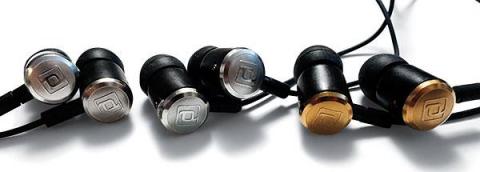We were lucky enough to be sent three out of the four headphones Periodic Audio has to offer: the Magnesium, Titanium, Beryllium as well as the Nickel. This young company wants to create the best audio experience by stripping away all the bulk and unnecessary frills and focusing on a high quality sound in a super portable way. Periodic Audio is a company formed to act as the self-funded, small team of audio product specialists, who want to produce “performance heavy, and buzzword-y feature impaired”, devices.
We are going to jump in with most expensive of the bunch: the Beryllium, or Be, has a 100% pure beryllium foil diaphragm with a bonded PEEK surround, which provides the best sound out of all three; highly comprehensive, layered and clean, you won’t miss a single note with these, they can handle some serious volume without losing detail and the passive noise cancellation means you can fully submerge yourself in the audio experience. Beryllium is one of the least dense stable metals, but among the highest Young’s modulus values (a ratio of the stiffness) and speed of sound, this all adds up to a high efficiency and extremely low distortion as the diaphragm does not bend on its own, moves homogeneously, and dissipates internal energy very well. All this means the Be is best suited for rock, jazz, classical, and country, an excellent choice the for eclectic music fan. There is a handy “Selectatron” on the website to help you choose the best headphones for your genre of music.
The Titanium or Ti uses a pure titanium foil for the diaphragm material. Titanium is widely used in aerospace and high-performance applications because of its mix of extreme strength and stability with moderate weight, giving it one of the best stiffness-to-weight ratios of all structural metals. The sound the Ti produces is punchy, with a stronger bass and treble, best suited for bass-heavy music like electronica and dance, and music, these aren’t as versatile across a wide range of music but bass heads will enjoy them.
The Magnesium or Mg headphones are the cheapest of the collection, these, unsurprisingly use a high magnesium content alloy (96% Mg) for the diaphragm material, as magnesium is the least dense of all stable metals, it is very high on the stiffness-to-weight ratio, and that is why it’s used in automotive and aerospace applications. These two properties result in a highly efficient, low distortion transducer foundation, it can produce a loud sound when needed, although when comparing it to the other two the sound is harsher in the high end with less power in the low end, these are best suited for more neutral genres, blues, acoustic indie and folk for example, and will cut through noisy environments. All components inside the IEMs (In-Ear Monitor) are 100% designed and tooled in-house, resulting in a totally unique product, all components are keyed so that assembly is nearly fool-proof and are finite-element analysed for stress, strain, and durability. The polycarbonate body is durable with zero resonance, custom front-and-rear tuned volumes, Metal-Injected-Moulded grade 304 stainless steel logo caps, butyl rubber strain reliefs, chemically-etched grade 316 stainless steel grilles, and N48H grade magnets, finished off with precision-bonding alignment with cyanoacrylate adhesives and sealed with polyvinyl acetate.
Each pair of earphones come in similar packaging, with Periodic Audio earbuds made from medical grade silicones and urethanes (S, M, and L of single flange, dual flange and foam units). There is a screw-top carry tin sized to fit inside the coin pocket of a pair of jeans, there is also an 1/4″ gold plated adapter jack and the lightweight, gold-plated aeroplane adapter. We found the wires are the type that like to tangle into a ball the moment you take your eyes off them but the carry tin helps to prevent this, the issue with the tin is that is isn’t as comfortable in your pocket as a fabric case may be, although it is highly protective. Other than providing you with high quality audio these earphones have no other features; no Bluetooth, no touch controls, no stand out visuals or call handling - and I for one love that - and I believe audiophiles will also appreciate the attention to sound. They are highly comfortable due to the lightweight design and can easily be worn all day without causing fatigue, making them great for travel, exercising or simply escaping the world around you. This brings us to the Nickel of Ni, this improves your sound quality by providing you with more power output than just about any portable solution on the market, whilst remaining smaller than some pairs of IEMs. This compact amp provides over 25 mW per gram, over 250 mW, a quarter of a Watt, per channel into 32 Ohms, nearly double that into 16 or 8 Ohms. This will give you 6.5 dB of gain without compressing the volume range of your phone, it is simple to use; just plug it in to turn on and unplug to turn off, attach it to your phone and you will gain hours of play time whilst it takes just minutes to recharge. You will get 8 hours of output from a good set of IEMs after 30 minutes’ charge, and the dedicated split power supply for the audio stage means you can charge as you listen. The petite device feels a little delicate and doesn’t come with any kind of protective case, although in the short time we have used it hasn’t come to any harm, add this to any of the earphones Periodic Audio have to offer for an instant boost.
4.5 out of 5
Pros
Excellent sound quality across all three models (Be, Ti and Mg)
Great sound to size ratio (Ni)
Focuses on sound quality and portability
Different IMEs suited for different genres of music
Solid build quality (IMEs)
Cons
Limited features (some see this as a pro)
Poorly packaged
No case (Ni)
Wire tangles up and feel fragile
Case can be uncomfortable in the pocket
- Log in to post comments

